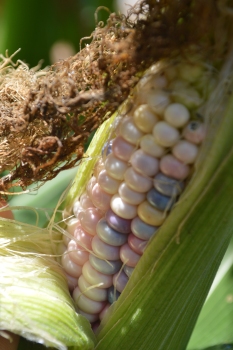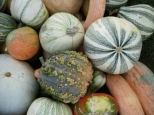Squash are either looked upon as amazing, sprawling, productive plants with a mind of their own, or else space hogs that need to be to be reigned in. Obviously I see nothing but beauty and inspiration in their vines, but one of the most FAQ that I get is how do you control them? The answer is simple, the more you try to rearrange their vines, cut them back, or run over them with a lawn mower, the more you are destroying your chances of being a successful squash grower.
I advise Hawaii growers to prune both Winter squash and edible gourds back once or twice a year, after harvest. What I hear, is a lot of people cutting off vines as they are getting ready to flower and set fruit, then they wonder why they didn’t get squash. Pick your battles here, folks. You get one or the other: tidy garden or squash. Considering that the state of Hawaii was down to one commercial grower before I started, one would think that if you got a plant established enough where it was spreading all over, you would leave it alone and let it reach out.
In the past few years, I have made some progress with inter planting with all kinds of things. Squash will crawl over everything, but it will also keep on crawling. I let the vine continue on its way and trim off the leaves that may be shading the pepper plant, or eggplant that it is crawling upon. Now there are a lot of different kinds of growers out there, and this will not set well with some, but for those with a small space, permaculture bent to them, this is for you. Before we go on, just note that squash produce their fruits on the ends of their outstretched vines. If you cut off these critical vines, you have made a prune that is going to really set you back. I know many lawnmower cowboys who fight me on this, but trust me cowboy, you’ve shot yourself in the foot.
Here are a couple of photos from my home gardening experiments. Today, I added additional pieces of bamboo this way and that, so to create a strong enough trellis for chayote/pipinola to smother. I crossed the bamboo and tied with wire. Two untreated shipping pallets can be seen in there as the base, and heavy pieces of bamboo get threaded into the sides of the pallet to create planes where the upwardly mobile vines can go. At the base, also you will find Winter squash, and Christmas lima beans planted. It doesn’t really matter who grows on what. All three are vines, all three are valued plants in the garden.
This garden is now overly shaded from the banana trees, so my focus is now the narrow windows of sunlight. These climbers are now at a point where they are up and out of much of the shade. This “living wall” serves several purposes, most importantly, it lessens the wind tunnel effect of this corridor garden. I also like the fact that it becomes a vertical place of interest as well. But equally important to me, is that it is a home for the Jackson chameleon family and their newborns. I care about such things, and I realize that many do not, but for me, leaving a permanent place where they can be fairly undisturbed has brightened many a day. Tonight, alpha male “Zig Zag” eagerly climbed the tallest of the new bamboo stakes before disappearing for the night.
Ever watchful, they seem to be aware of who is looking out for them by building gardens with trellises to climb. These East African chameleons are a highlight to my day. They too are great climbers, but get themselves down to the ground to eat snails and slugs. They are territorial by nature, so if they like a spot, they will remain there and have their family there. I have been blessed with seeing them in all ages, from those only a few days old, to full grown. I have treated them for injuries and dehydration when needed, and I have learned so much about them in the process.
On the flipside of this wall, I have created a mini garden that gets a lot more sun. In December, I transplanted the leggy seedlings, as well as the aging, may not germinate seed, and got this! A lovely mix of all the things I love. A little bit of everything planted quite closely together. So close, that I have to be really proactive with the fish fertilizer, as in, fertilize tomorrow because these plants are beginning to fruit.
I should also mention that banana stumps create the border for what is a very shallow raised bed garden that is at the base of this climber trellis. The nutrients of these bananas stumps will continue to seep out, and eventually, they will breakdown in place. A new stump can be piled on top, and continue the cycle. I’ve found these to be excellent cool places for worms to have their offspring. All of these reclaimed things were free to use in the garden.
Hawaii’s seasons come and go in such a way, that you can keep some plants going for quite a long time. Some peppers and eggplants last over 2 years with proper care. They do not fruit year round, nor do they have the enormous yields like they do in many parts of the country, but they can be fixtures to count on and plan around. Lima beans need a very long season, as do so many of the Winter squash that do well in Hawaii. So think ahead, and plan on those plants to be in the same spot for 6 months or more. If you think ahead, and leave them alone as they grow, you may find that you like the look of sprawling vines after all, especially after eating the bounty of the season.


















































